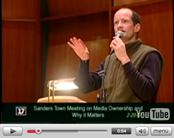Curriculum Review - Sex, Murder, and Video Games
Title: Sex, Murder, and Video Games
Creator: David Walsh and Mediawise/National Institute on Media and the Family
Format: VHS
Length: 16:30
Ages Appropriate: Teens and older, definitely not for small children or early adolescents
Overall Recommendation: tentatively meets ACME standards, though it was close
Standard #1: ARE FUNDED through independent means with no direct financial support from transnational media conglomerates.
This video is produced by the National Institute for Media and the Family, and has no obvious connection to, nor financial support from, transnational media conglomerates.
Standard #2: ARE FREE OF unexamined commercial product placements.
The only product placements in this film are excerpts from the game that are fully examined and critiqued by Dr. Walsh. No other product placements are found.
Standard #3: CONTAIN supporting curricula resources – questions and answers, pre and post-viewing activities, and/or background or supplemental materials for classroom and community educators.
A brief, six page, discussion and activities packet is enclosed. The packet has discussion points, a few follow up activities, and an abbreviated resources section. It would be helpful for someone using this type of resource for the first time, or with an audience they didn’t know well. It provides leading questions, some critical analysis work, and resources for further learning.
Standard #4: PROMOTE critical thinking through the application of various media literacy skills (access, analysis/questioning, evaluation, discussion, reflection.)
This video and its information packet do concentrate on analysis/questioning, but neither build on the other elements of media literacy skills. There is little reference to accessing, evaluating, or discussing, since most of that work is done for you in the video. The message isn’t reflective, it works mainly to point out misogyny and violence in video games and to point out the negative impact that might have on young adults. There is no mention of production at all. One may have hoped for a more progressive pedagogy to inform the video’s production, but it is essentially a lecture on the evils of sexy and violent videogames and how they might effect players and society at large, illustrated with film clips of the games more violent and stimulating moments.
Standard #5: FACILITATE active “hands-on” learning activities and independent media production (i.e. - writing, filmmaking, multimedia creation).
Not applicable – though there is one “production” activity listed in the discussion guide, asking students to examine ads in gaming magazines and discuss them.
Standard #6: ESPOUSE media-related activism in one’s school and/or community, encouraging students to move from “passive consumer” to “active citizen.”
Not applicable – though I think it should have been, and that may be a fault with this resource. The discussion guide does use language that may be seen as progressing to “active citizenry” by asking “what to do?” about these games. Activism does not seem to be a focus of this work.
Standard #7: ADDRESS the positive/negative individual and societal effects – social, economic, cultural, political, psychological, spiritual, environmental – of media consumption
Meets this standard easily. The video is meant to explore the individual and societal effects of video game violence and misogyny, and does that very well. It is the main purpose of this video and the support for the harm that these games may do is developed very well.
Standard #8: EXPLORE the structural and societal implications of media’s creation, financing, and distribution.
Not applicable, nor mentioned in any fashion.
Standard #9: CHALLENGE the current corporately-owned Big Media status quo in a specific, documented, and fearless manner.
My feeling is a qualified yes, this video does take on the current mania for faster, sexier, and more violent video games by intelligently pointing out the cumulative effects that such games have on both the players and society. But, it doesn’t call for change in the games, point out alternative games that aren’t as harmful, nor call for the development of new games that wouldn’t have sex and violence as their main focus.



![View your cart items []](/sites/default/modules/ecommerce/cart/images/cart_empty.png)




